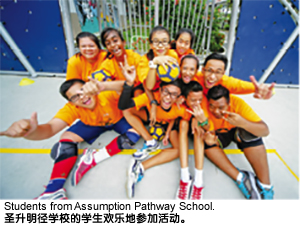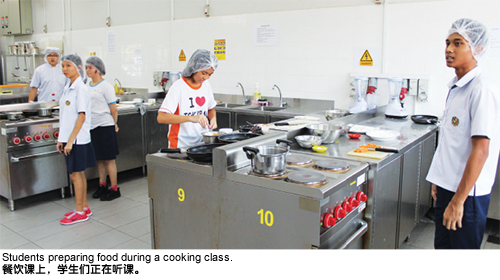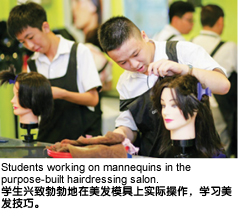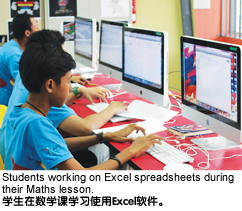
Some may think of Singapore as having an unforgiving educational landscape, where students who do not do well in school have no future. But there are schools that offer such students a safety net and where different methods are employed to give them the skills and knowledge to survive and prosper in the modern world.
One such school for students in Singapore who fail their Primary School Leaving Examination (PSLE) or who are struggling in mainstream schools is Assumption Pathway School (APS). Previously known as Assumption Vocational Institute, the School, which accepts students who have failed their PSLE, would usually be regarded as a last resort. But for the many youngsters who have passed through its doors, the School has been a blessing as it has provided them with engaging learning experiences in a caring community.
Student Enrolment at APS
Mr Wee Tat Chuen, Principal of APS, said that the School currently has about 600 students — its full capacity is 700 — and takes in 180 new students each year. Its population is kept small so that each student enjoys individualised attention.
 The bulk of the students who enrol at APS are those who have failed the PSLE. First time failures are encouraged to take the PSLE again, but for those who prefer to move on to a more hands-on education, APS will take them in, starting from the weakest. The bulk of the students who enrol at APS are those who have failed the PSLE. First time failures are encouraged to take the PSLE again, but for those who prefer to move on to a more hands-on education, APS will take them in, starting from the weakest.
Because students in general have been receiving more help for their PSLE, APS is actually seeing a decrease in the number of students who fail the PSLE a second time, and therefore the School currently has more academically weak students who have failed the PSLE once rather than two or three times.
In the past, Assumption Vocational Institute was a place where students who had no other pathways open to them could go. After it became APS, the teachers wanted to keep this option open for such students, but only for those who really needed it.
Mr Wee said, “At the end of 2008, I had this file of applicants who wanted to transfer from mainstream schools or had dropped out of mainstream schools, but it was hard to decide who to accept. I had a discussion with the teachers and they said that APS has to continue accepting dropouts because the School was set up as a place which students can turn to as a last resort. But they also said we needed to be more selective because in the past, Assumption Vocational Institute had taken in more mature students and they tend to pose more discipline problems given their age profile, and could adversely influence the younger students.
“I made a decision based on what the teachers said. To be intentional in reaching out to the right target group, we organised a briefing for those who wanted to apply to APS. My first message to them was to stay in their secondary schools because it would be better for them as they would have a wider range of options when applying to the Institute of Technical Education (ITE). They were told to think through their decision and not come to us just because they wanted to avoid the discipline issues they may be facing in their secondary schools. For those who knew they would benefit from a vocational education and really wanted to come, we interviewed them and we placed the successful applicants on a one-month probation. We want to be very serious about how we take in these students so we can help those who will indeed benefit from a more hands-on education.”
What the School’s students benefit from is a curriculum which also allows them to take accredited courses should they wish to join the workforce straight after graduation.
Accredited Courses
Students at APS undergo a three- or four-year programme, and graduate with an ITE Skills Certificate in one of five courses: Baking Practices, Desktop Publishing and Design, Facility Services, Hairdressing, and Hospitality. Mr Wee said that not all the courses were available immediately when the School started.
“We added courses along the way because as we worked with students, we realised that we had those who were, for example, good in hairdressing. If they were to do just an elective or a module, they can’t go far. So we worked with the ITE to introduce a full certificate in hairdressing. Likewise for Desktop Publishing and Design, students could only do the subject after graduation with external providers; so we worked with ITE to introduce that as a course here at APS.”
Desktop Publishing and Design was only introduced last year, and students taking the course purchase their own MacBook which they can do work on and keep after they graduate. “We have conversations about what is best for the students, and it was the Head of Department who said to let them have the MacBook so that they can learn and work in the same way a designer would in a real work setting,” said Mr Wee.
APS also offers short-term Work Skills Qualification (WSQ) courses from the Singapore Workforce Development Agency (WDA) to boost the students’ future employability. The WSQ courses offered include baking and housekeeping.
“We introduced the WSQ in housekeeping and students meet twice a week for about two to three hours each time. After 13 weeks, they go on a short attachment, and they get accredited by WDA,” Mr Wee explained.
Hands-on Curriculum
 There are plenty of opportunities for students to get hands-on training around APS, such as at the Assumption Restaurant for Training or The ART. The seed for The ART was first planted in 2009 when students were given the opportunity to prepare and serve lunch to teachers and their guests every Friday. After seeing how the students learnt from the experience, the School expanded the idea and The ART became a full-time training restaurant open to the public for lunch and tea every school day. The restaurant is also open when the School has special functions. There are plenty of opportunities for students to get hands-on training around APS, such as at the Assumption Restaurant for Training or The ART. The seed for The ART was first planted in 2009 when students were given the opportunity to prepare and serve lunch to teachers and their guests every Friday. After seeing how the students learnt from the experience, the School expanded the idea and The ART became a full-time training restaurant open to the public for lunch and tea every school day. The restaurant is also open when the School has special functions.
“We decided to open a full restaurant because we know that some of our graduates will not be able to go to ITE, and they may not be able to assimilate into the workforce immediately, so we let them work at the restaurant and pay them a small allowance for a year before they go out into the real world. We have about 15 students at the restaurant, half of whom have already graduated.”
APS has also recently launched the Enterprise Hub, a place where between 9 to 12 students practise entrepreneurship by selling products and services like freelance photography and design. Students in Baking Practices also sell their products there. Mr Wee hopes that this can become a platform where students can learn to make a living through combining their skill set with an entrepreneurial mindset.
Work Exposure
Other than the experiences students can gain in school, APS partners about 30 organisations to equip them with work experience.
“We have very good partnerships with corporations largely because we have a very strong and active School Management Committee. While we have initiated some partnerships, they have been key in arranging many of the partnerships we have built up over the past five years,” Mr Wee explained.
From Year 2, students work at different places for a week and perform different duties so that they have a better feel for various industries. In Year 3 and Year 4, students get to go on two-week internships before the December and June holidays respectively. If they wish to continue their internships during the holidays, they can.
The work exposure opportunities culminate in a career fair for the graduating students at the end of the year, at which organisations set up booths where students can enquire about and apply for jobs.
Value-added Programmes
Apart from the curriculum and work exposure, an important part of the APS experience is its value-added programmes.
 An important one of these is the annual APS Challenge, where students choose one of 30 different challenges which range from physical activities like scuba diving and climbing Mount Kinabalu, to community work initiatives like going to Cambodia to help in an orphanage. The APS Challenge is supported by NTUC Income. Besides contributing financially, staff from NTUC Income also volunteer as mentors to the students for the programme. An important one of these is the annual APS Challenge, where students choose one of 30 different challenges which range from physical activities like scuba diving and climbing Mount Kinabalu, to community work initiatives like going to Cambodia to help in an orphanage. The APS Challenge is supported by NTUC Income. Besides contributing financially, staff from NTUC Income also volunteer as mentors to the students for the programme.
Mr Wee said, “We have the APS Challenge because we want to send two key messages to the students. The first is that just because they failed the PSLE it doesn’t mean that they can’t have dreams and aspirations. The second more important message is for them to take action to make their dreams come true.”
Students embark on a new challenge every year. They do a class challenge in Year 1, a challenge of their choice in Year 2, and a vocational challenge in Years 3 and 4. Students work on their challenges two hours a week, for 15 weeks. When the challenges are carried out, classes stop for a week. The students then give a presentation to their level mates about what they have learnt.
Another value-added programme is the iSTAY Programme. For this, students stay in the purpose-built hostel for a week at a time, up to a total of six weeks, during their three or four years at APS. To facilitate interaction and relationship-building among students and their teachers, only 60 students stay in at any one time.
Mr Wee said, “The idea for the iSTAY Programme started when the founding committee for the School held focus group discussions with students and found that a number of them didn’t go home to intact families. They would just loiter around without any structure or routine. Our first objective is therefore to help inculcate a sense of these in their lives. For example, even though students do not attend classes the week they are at the hostel, they still join the rest of the school for flag raising.
“The second objective is to build communal living. We want them to understand what it means to live together, have duties, clean up after themselves and so on. We are happy with the results, and the children are responding well too. Every time I see them I ask if they are enjoying themselves, and they say yes. But when I ask if they would like to stay longer, they say no. They do miss their freedom and their families. They tend to better appreciate the things they have when they are away.
“The iSTAY Programme also allows the social workers to do some work with the students and their families if they are aware of existing issues. When parents come in for parents’ night on the last day, the social workers can get a chance to talk about things and engage the families at a deeper level.”
Pastoral Care for Students
There is a greater need to reach out to students at APS because of its composition. Statistically, more than 50 per cent of those on roll are on financial assistance, about 20 per cent come from dysfunctional families, and about 20 per cent are diagnosed as having learning needs.
 When working with students to develop good habits, structures and routines, staff and teachers have to also take into account the students’ histories, including their previous school attendance and struggle with academic studies, as well as their living conditions. While the majority of students respond well, some need more guidance. When working with students to develop good habits, structures and routines, staff and teachers have to also take into account the students’ histories, including their previous school attendance and struggle with academic studies, as well as their living conditions. While the majority of students respond well, some need more guidance.
As such, form teachers are the front liners at APS. They are put in charge of a class of 20 students and will stay with them for two years so that deeper relationships can be fostered. Besides the form teachers, every level has a four-member team comprising a level master, a discipline teacher, a counselor, and a social worker.
Each four-member team meets on a weekly basis to talk about case management, and they also meet level teachers once every two weeks. Teachers can refer students who have deeper problems to the counselors. Likewise, when the counselors note that the problem is not just with the child but the family environment he or she is in, the counselor will engage the social worker.
Involving social workers was a decision that was made within the first two years of starting APS, as Mr Wee noticed that teachers and counselors were carrying out so many home visits on top of the work they had to do at school that they needed additional help, so the School raised the necessary funds to engage social workers. The social workers share their specialist knowledge in reaching out to students and their families, and they work in tandem with the teachers and counselors.
“Even if they have gone on home visits themselves, I hear teachers say that they learn from the social workers about the ways to approach various situations. The parents are also more open to the social workers given their experience and competencies in engaging with families in need.”
Future After APS
APS’ first batch of students enrolled in the three-year programme graduated in 2011, while the first batch of students from the four-year programme graduated last year. The School aims for 40 per cent of each cohort to enter ITE, although Mr Wee predicts that not all will be full-time students. Instead, some will sign up for the Traineeship Programme, where they will be able to do on- and off-the-job training and earn some income.
“I would say that almost every student wants to go to ITE because that is their aspiration. But some of them will probably not be ready for ITE by the time they graduate, because of the accumulated deficit since their early schooling years. What we tell them is that they’re not failures just because they cannot make it into ITE. They can go out and earn an income, learn on the job and then upgrade themselves. After some time, some of them might still be able to go to ITE for part-time classes,” Mr Wee said.
Even after graduating some students come back for advice, help, and even to volunteer. For instance, past students have come to speak to current students during the iSTAY Programme. One ex-student returned to The ART every Saturday for one-on-one training sessions with the APS trainer, as he was having trouble mastering Asian cooking.
“What we do is continue to maintain the connection with them,” Mr Wee said. |